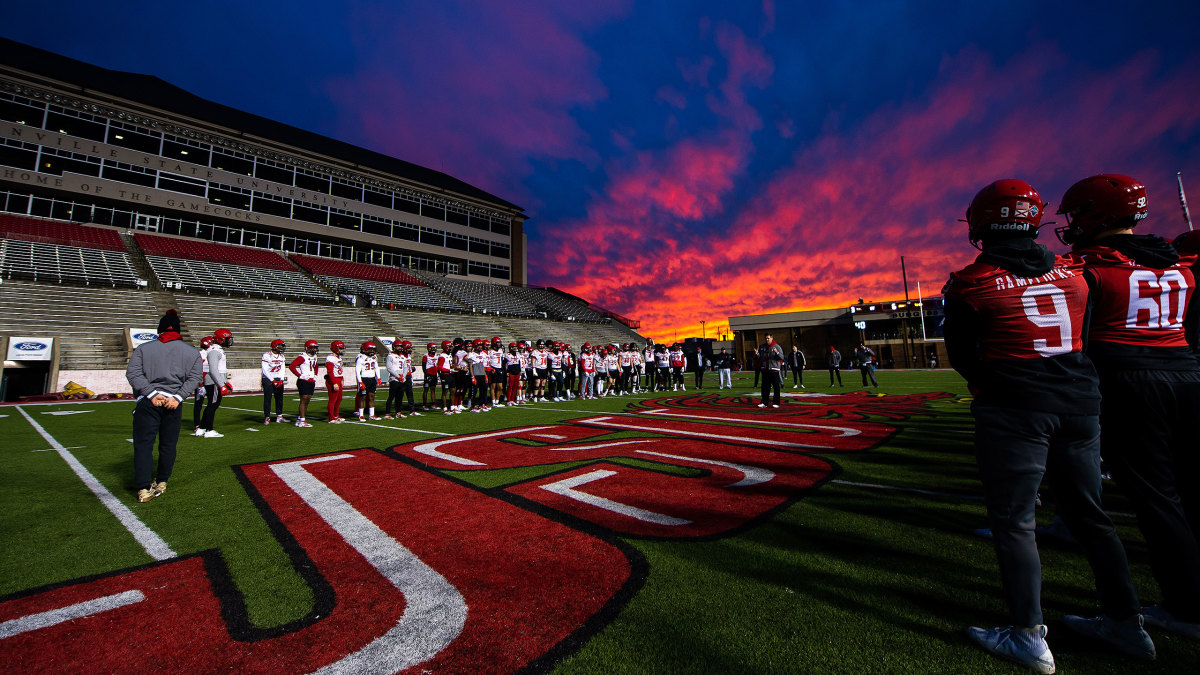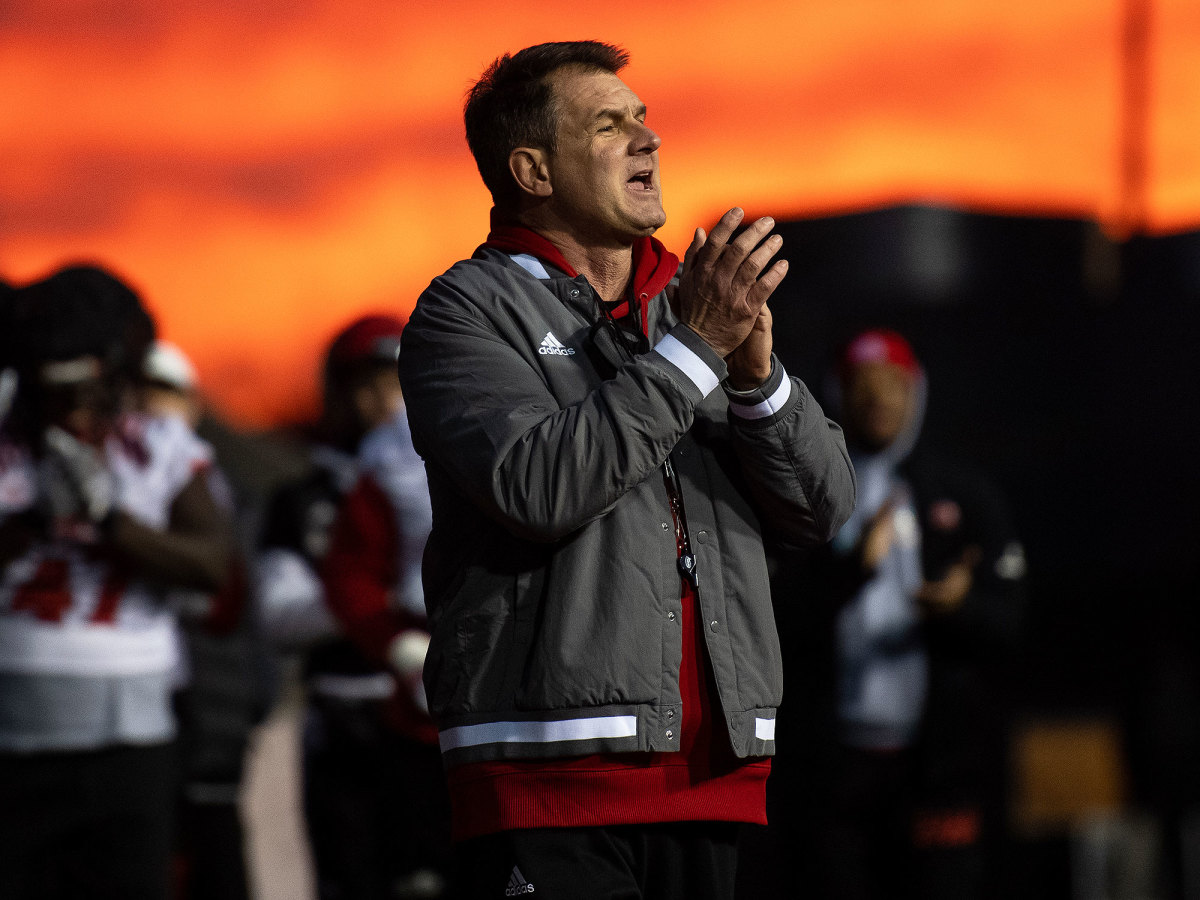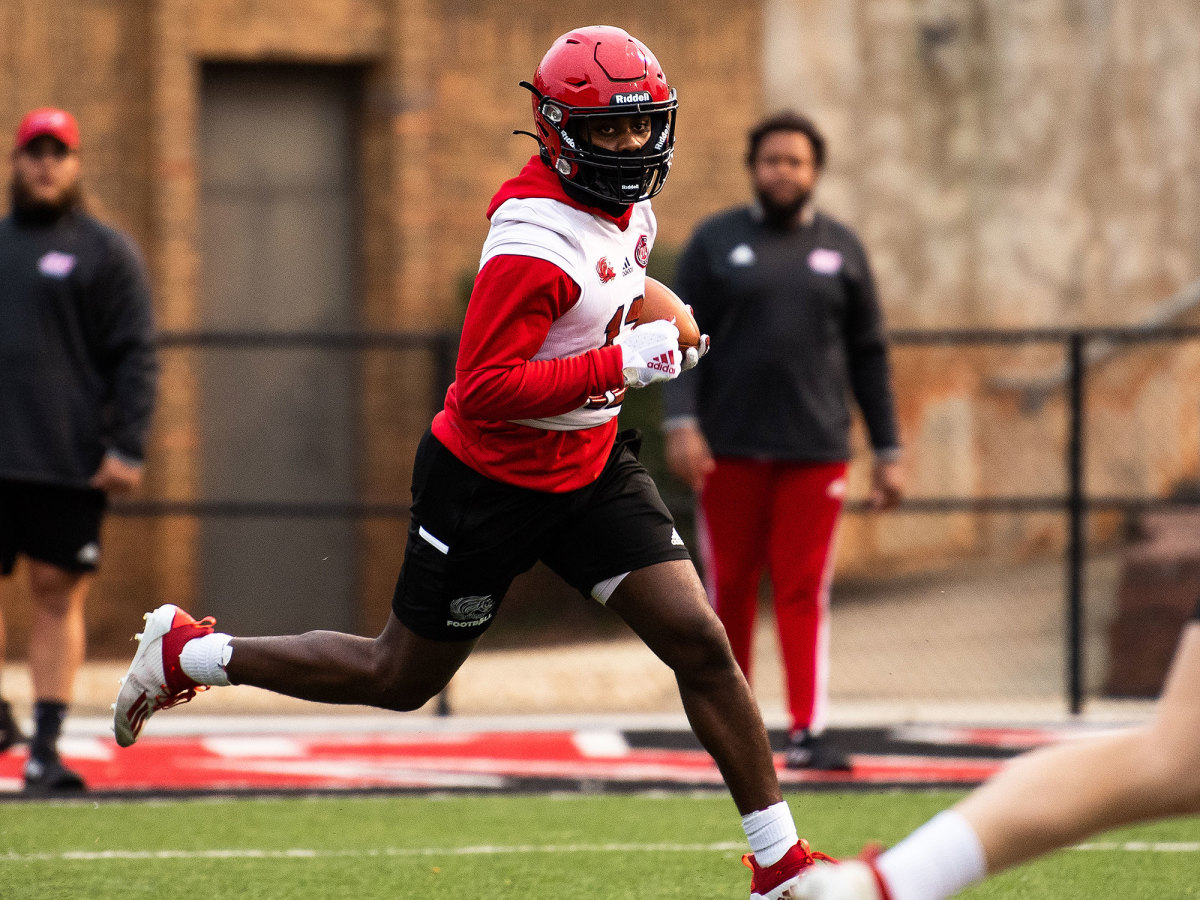Three Seasons in One Year? Jacksonville State's 'Unheard Of' Schedule Breaks New—and Uncertain—Ground

JACKSONVILLE, Ala. — Dustin Hill is jostling down two flights of stairs in quite a hurry.
Soon he’ll be the last one to arrive at the morning staff meeting and the first one, as it turns out, with the floor to himself. As the head athletic trainer at Jacksonville State, Hill’s responsibilities, especially this year, stretch beyond the injury report.
“I’m the COVID-19 expert and I’m the weatherman!” he says, shaking a printed weather report in his clenched fist.
For days now folks here have been buzzing about the impending winter storm. Even before Hill reads his report aloud, the entire football coaching staff seems aware of the elements awaiting them at the afternoon’s practice. And if they don’t know, they’d only need to glance through the single window of this cramped conference room to find the answer: gray skies, frosted treetops and their football field awash in snow.
“So,” head coach John Grass looks toward Hill, “it’s not going to get above freezing today, that right?”
Although this weather event, even for mid-February, is an anomaly here in the Deep South, it doesn’t exempt the peculiarity of it happening five days before more than 90 college football teams begin their season. Across the country this week, the first football game week arrived for those in the Football Championship Subdivision, the lower level of NCAA Division I that delayed its season to the spring because of COVID-19.

Week 1 preparation unfolded in the bitter February cold, far removed from the heat of August, its traditional place on the calendar. Instead of concerns over heat exhaustion, there were worries of hypothermia. Cooling misters, typical for a fall camp, were replaced with electric heaters, and some teams even practiced inside basketball gymnasiums.
This snow-swept day in north Alabama is the latest bizarre twist in a most unusual year for the Jacksonville State Gamecocks, a program that decided to play both last fall and this spring. They began practice in July, held what amounted to a two-month-long preseason camp, and then played four games in October before taking off eight weeks. They returned in January for a second camp, were scheduled to begin a seven-game spring season Sunday at Tennessee State and then, after all of that, plan to complete a full, 11-game schedule this coming fall.
The Gamecocks, and a handful of other FCS programs, are assured of playing at least 18 games in a nine-month span. With a deep playoff run, JSU would participate in more than 20 games in less than a calendar year and more than 25 in 13 months—something many historians believe could be a first in the college ranks.
Even within their own program, there is uneasiness, from players, coaches and medical staff alike, that such a grinding slate will inflict damage to athletes’ bodies as well as, experts contend, their brains.
“It’s unheard of,” says Hill. “We have no road map in navigating through this. No one’s ever done it.”

Inside Jacksonville State’s offensive meeting room, a debate is raging among coaching staff members.
In this bizarre FCS spring season, 10 teams played at least one game in the fall, but the vast majority of programs, including JSU’s original opponent this Sunday, Tennessee State, will be playing their first game in more than 15 months.
So what group, coaches argue, has the advantage? While Tennessee State owns fresh film on the Gamecocks, Grass’s team is a more seasoned unit, but they are without recent footage of their opponent.
“We’re watching film of them and it’s almost 2 years old,” says Cody Wells, JSU’s receivers coach. “You don’t know what they’re going to do or who they’ve brought in.”
This is the weird world of FCS football in 2020–21. It got weirder, too, on Wednesday, when Tennessee State, citing the wintry weather and icy field conditions, delayed Sunday’s game until March. The Gamecocks will have to wait another week to open the spring slate.
In the FCS some conferences granted their teams permission to play a minimal number of games in the fall, mainly for budgetary reasons, allowing them to cash six-figure checks from games against FBS programs.
Seventeen teams played this fall in mostly nonconference games, seven of which are choosing not to play their conference schedules in the spring. More than 20 other FCS teams chose to altogether opt out of the season, both fall and spring. None of the Ivy League’s programs will play, and the MEAC canceled its conference schedule as too few members chose not to play.
Jacksonville State chose a unique path. The Gamecocks played more games this fall than any other team scheduled for a spring season, excluding The Citadel, which also played four. They opened at Florida State, failing to hold a first-half lead and losing 41–24, before winning games against Mercer, North Alabama and FIU.
JSU’s early lead in Tallahassee captured the nation’s attention and reminded folks about this small school (7,700 undergrads) in rural northeast Alabama. It wasn’t a first. Jacksonville State nearly beat Auburn in 2015, taking the Tigers to overtime before losing 27–20. The Gamecocks have recently been on a tear within the FCS ranks, storming to the national title game in 2015, participating in 12 playoff games since 2013 and winning five consecutive OVC titles in the last six seasons.
Yet the world still often mistakes Jacksonville State for other schools, says Greg Seitz, the athletic director at JSU. The school occasionally receives mail addressed to Deion Sanders, the new head football coach at Jackson State, at the SWAC program in Jackson, Miss. And many believe that the university is located in Florida.
“So,” they’ll ask Seitz, “how far are you from the beach?” (Jacksonville State is about 300 miles from the beaches of the Florida panhandle, by the way.)
In one of the wildest confusions, Seitz once received a six-figure game check in the mail from an FBS program that intended to send the check to Jackson State. And no, he didn’t cash it.
He did, however, cash the $750,000 in checks from games against Florida State and FIU last fall. That accounted for one-quarter of his annual football budget—an obvious clue in the school’s motivation to play last fall.
But it wasn’t without debate. Grass, an easygoing former high school coach in Alabama who took over here in 2014, left the decision up to his team. For about two weeks in August players expressed serious concerns about playing in the fall. At one point about 80% of the team was indecisive and the other 20% was split on playing, Grass says. When the NCAA granted athletes an extra year of eligibility for the COVID-19 season, enough players agreed to play despite concerns from their own parents.
For instance starting center Zack Cangelosi, a former walk-on with trunks for legs and hair past his shoulders, found himself having to convince his mom (fearing COVID-19) and his dad (fearing for his son’s physical health) that it was the right decision. Some family members pressured safety Jeremiah Harris to opt out after his uncle died of the virus in August.
And then there was Treylen Brown, a redshirt freshman offensive guard, the only JSU player to opt out of the fall season. He left the team in August to return home to South Carolina to care for his mother, who had breast cancer. With her now cancer-free, Brown is back with the team after a scary incident in the fall. Following a double mastectomy, Alveta Brown suffered from internal bleeding and nearly died while in the hospital.
“She tells me all the time, ‘I saw the light,’ ” Treylen says. “God knew I needed to opt out to be there for my mom. She’s been there for me for 20 years.”
Treylen Brown is the rare person here happy the FCS moved the conference and championship portion of their seasons to the spring—he now gets to compete. But many are frustrated that more than 120 FBS programs played full seasons, won championships and completed a playoff last fall.
“Looking back, we could have competed. That was proven at the FBS level,” says Seitz, a proponent over the summer in the FCS holding a fall season.
FCS teams bailed on 2020 fall for a variety of reasons, administrators say. For one, testing costs last fall were overwhelming for programs with budgets diminished by their FBS brethren. Not only have prices dropped but the accessibility of testing has greatly improved, too.
The Ohio Valley Conference, home to JSU for at least a few more months (the Gamecocks move to the Atlantic Sun next year), was one of the last FCS conferences to push its season to spring, a move that commissioner Beth DeBauche attributes to the league’s legion of athletes, not finances.
“Our athletes had some level of anxiety that there was too much uncertainty at that time,” she says. “It was the right decision.”
It comes with consequences, though. At JSU, all 16 sports are happening this spring. Medical and administrative staff are stretched thin. Some home events will be played without a licensed athletic trainer, a concerning issue, says Hill, the 50-year-old athletic trainer.
For Grass, the biggest worry is his players’ bodies and minds—for this year and years to follow. The offseason is a critical time for development and recovery. His incoming freshmen will miss this offseason and his older players will miss a second consecutive offseason.
“Some of these teams are gung ho about playing in the spring, but you ain’t thinking you have to turn around again and play in the fall,” Grass says. “I’ve been concerned.”

J.R. Sandlin, Jacksonville State’s recruiting coordinator, refers to the team’s preseason camp in August and September as “the world’s longest practice.” And maybe he’s not wrong.
The Gamecocks geared up for a fall season with all other teams in late July, and then found themselves still practicing in late September without having played a game. Hoping to preserve his players’ bodies, Grass didn’t conduct a traditional camp. The Gamecocks alternated between heavy contact days and light practices.
After Thanksgiving with their four October games behind them, players were off for eight weeks. They returned for Camp No. 2 in mid-January, ahead of the seven-game spring season. Seven games could turn into eight, nine or even 10. The 16-team FCS playoffs start April 24, and Jacksonville State is one of the favorites to win the Ohio Valley Conference and claim an automatic postseason bid.
“What impact is this going to have in playing 20 games in a 10-month period?” asks Seitz. “It keeps me up at night. And if we do have a significant injury this spring, it’s going to cost the kid two seasons.”
Because this is unprecedented, no one really knows how much downtime is needed between the end of a spring season and the start of the 2021 fall camp. For now this subject is the topic of ongoing debate among NCAA officials. “Legitimate space” is necessary before a 2021 fall season begins, says DeBauche. For now, the Ohio Valley Conference is planning to start its fall season on time, but officials remain open-minded about that.
Teams that do not make the playoffs will have about three months before resuming contact activity in late July or early August. Those making deep runs in the playoffs—the championship is scheduled for May 15—will have roughly two months.
Some medical experts are concerned.
“That is ill-advised. Three months is not enough time for the brain to recover,” says Eric Nauman, a professor of engineering and medical sciences at Purdue who, with fellow professor Thomas Talavage, is responsible for groundbreaking research on brain trauma in football players.
In a project that dates back to 2009 and includes nearly 600 athletes, mostly high school football players, researchers found that half of a team will experience dramatic changes in the brain from subconcussive impacts of a single season. That brain trauma, measured through preseason, in-season and postseason MRIs, takes as many as five and six months to recover.
Without time to heal, the brain could withstand what’s considered chronic inflammation, which could lead to cognitive dysfunction late in life.
“If you continue to impair the structure in the brain, that is the logical extension,” says Talavage.
At least one school opted out of the spring season for this specific reason. Campbell played four games this fall and canceled its spring because of concerns from coach Mike Minter, himself a former college and NFL player at Nebraska and with the Panthers. Minter says a spring season is much different than a spring practice, which only includes 12 full-padded days of drills spread over a month.
“The competitor in me says let’s go strap it up in the spring, so we can go try to win a conference championship and go to the playoff,” Minter said in an interview in October. “But the football player in me, the one who played 10 years in the National Football League and before that, Nebraska, listen, there’s a reason we get all that time off in between, and it’s not because we’re lazy.”
Jeff Dugas, a member of the NCAA Committee on Competitive Safeguards and Medical Aspects of Sports, the group that approved the FCS’s spring season plan, believes that coaches are taking enough precautions in their practice structure to prevent ill effects. That said, his primary concern is a potential uptick in injuries in the fall.
“There was nothing ideal about this,” acknowledges Dugas, Troy’s team doctor and an orthopedic surgeon based in Birmingham, “but I think it was the best solution to the problem.”
Players have their own worries.
“What’s going to happen in Week 7 of the fall season when we’ve played 20 games in a year?” asks Brown, JSU’s redshirt freshman guard. “It’s a little concerning. It’s a lot of football, but our trainers know what to do. They’ll figure it out.”

Back in the morning staff meeting on this wintry Tuesday in February, Hill has wrapped up his injury and weather reports and has now turned to the toughest opponent of the year: COVID-19.
Listed on his COVID-19 report are eight players who have tested positive in the last 150 days, meaning they are not required to be tested weekly like everyone else within the program, per CDC guidelines. Counting support staff and coaches, about 20 people are on the no-test list, including Grass himself. (He was asymptomatic earlier this fall.)
In all, Jacksonville State’s COVID-19 testing this school year for all athletes will cost a projected $300,000, all of which will be covered by the $2.2 trillion Coronavirus Aid, Relief, and Economic Security Act (CARES) that the government passed last March.
Of the 200-plus members of the Jacksonville State football team, including players, staff and coaches, about 100 have tested positive since the summer, Hill says. While that figure is jarring, it is on pace with many college programs around the country. Only three of those positives showed symptoms that he would describe as worse than mild.
Standing at the front of the room, Hill finishes his report prompting Glass to glance up from the table and ask a rhetorical question about a pandemic that has affected the world, a question that all of us are asking internally:
“When are we gonna get back to normal?” he sighs.
As if COVID-19 isn’t enough, the Gamecocks on this Tuesday afternoon collide on an artificial turf field that feels frozen solid. The wintry preseason camp, while different, isn’t necessarily a negative, says Tory Lindley, the president of the National Athletic Trainers’ Association.
“This week is a weather anomaly. There should be more environmental safety benefits to the timing of the spring season compared to the negative impact of the heat,” Lindley says. “It's easier to manage the cold than the heat.”
However, Todd Berry, the executive director of the American Football Coaches Association, has heard from coaches of the FCS’s northernmost schools that do not have indoor facilities and are battling negative wind chills when they’d normally be camping in 75- to 80-degree temperatures.
“Coaches have called me, ‘This has been so hard,’ ” Berry says.
Meanwhile in the Ohio Valley Conference, DeBauche is navigating the impacts of the wintry weather on the season’s first weekend of games. Some schools, inundated with snow, may not be able to travel. Others are concerned about ice on their fields.
It’s another reminder that this is unlike any other season-opening week of college football. It will get weirder, too. The season-ending national championship game is scheduled for mid-May under the Texas sun.
“Start with snow,” quips Sandlin, JSU’s recruiting coordinator, “and end with sweat!”
